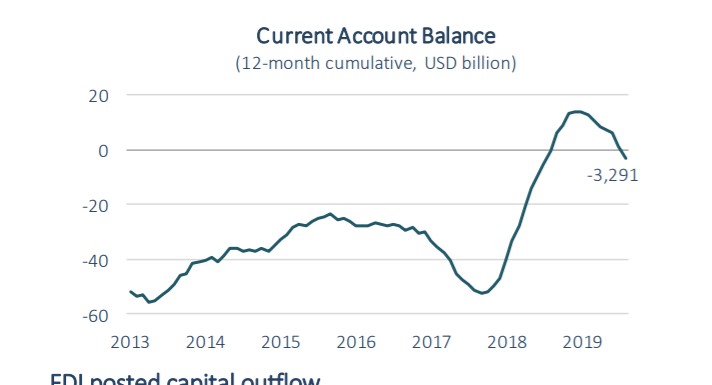In April, the current account deficit (CAD) was reported as $5.1 billion which is approximately 11 times higher than the same period of last year. The market expectation was that the current account deficit would be around $4.5 billion. The absence of tourism revenues and the rapid decline in exports were behind the deterioration of the CAD. In April, 12-month CAD catapulted to its highest level since March 2019 with $3.3 billion.
Foreign trade deficit at $4.6 billion
According to TURKSTAT data, exports declined by 41.4% yoy to $9 billion in April, while imports shrank by 25% yoy to $13.6 billion. Thus, foreign trade deficit widened by 67% yoy, to reach $4.6 billion. During January-April 2020, the deficit rose by 102.3% yoy. The import coverage ratio, which was 87.4% in January-April 2019, declined to 74.7% in the same period of this year, writes the research team at Is Bank.
Capital outflow continues through portfolio dis-investments
There was a net capital outflow of $2.4 billion through portfolio investments in April. In this period, non-residents sold $847 million in the stock market and $2.8 billion in debt securities market.
Following the outflow of $2.9 billion in March, “other investments” account had a net capital inflow of $192 million. In this period, deposits of domestic banks at their foreign correspondents rose by $2.3 billion, while foreign banks’ deposits at domestic banks increased by $742 million. Regarding external borrowing, both banks and the non-financial sector were net payers in their long-term debts.
According to 12-month cumulative figures, the long-term debt roll-over ratios became 73% in the banking sector and 84% in other sectors as of April.
FDI posted capital outflow
In April, there was a $118 million net capital outflow in foreign direct investments account. In this period, the outflow in other capital investments became $452 million. Real estate investment inflows decreased by 57.1% yoy in April to shrink to $100 million.
Reserves decrease by $8.6 billion!
Following a rapid decline of $16.6 billion in March, Central Bank reserve assets declined by $8.6 billion in April. In this period, net errors and omissions also posted an outflow of $1.2 billion.
Financial stability in jeopardy
Turkish economist, academician and columnist for BloombergHT.com news site Mrs Gizem Oztok Altinsac wrote that banks have limited their FX debt rollover ratios to 70-75% in April-May, while the non-financial sector averaged 80-85%. For the last 1.5 years Turkey is delivering, which means the borrow-and-grow model is dead.
Oztok-Altinsac pointed to high inflation and the return of the CAD as main risks for Turkey going forward. She added that artificially low rates and a massive credit boom jeopardized financial stability, as the private sector revisits balance sheet risks. She claims private sector fixed investment have been deferred once again.
With Germany, Russia and Iran unable or unwilling to send tourists to Turkey, the country’s leading FX earner is out of the game for 2020. On the other hand, despite new import taxes and non-tariff barriers, normalization of the economy will boost import demand, healing rising trade deficits over the summer months. With ultra-low interest rates and dwindling reserves, Central Bank may experience difficulties in managing the exchange rate.
Turkey has averted a currency crisis in March thanks to draconian restrictions on the capital account, but in autumn the threat could come back.
You can follow our English language YouTube videos @ REAL TURKEY: https://www.youtube.com/channel/UCKpFJB4GFiNkhmpVZQ_d9Rg
And content at Twitter: @AtillaEng
Facebook: Real Turkey Channel: https://www.facebook.com/realturkeychannel/
